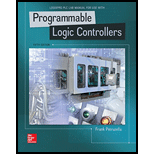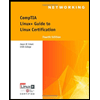
LogixPro PLC Lab Manual for Programmable Logic Controllers
5th Edition
ISBN: 9781259680847
Author: Frank D. Petruzella
Publisher: McGraw-Hill Education
expand_more
expand_more
format_list_bulleted
Question
Chapter 3, Problem 1P
Program Plan Intro
Programmable Logic Controller (PLC):
- PLC is a specialized computer used in industrial segments to control machines and process.
- PLC is program that consists of a set of instructions which resembles the controlling functions needed to perform specific tasks.
- The function of PLC is similar to that of a relay and hence, in an industrial segment a relay is greatly replaced by a suitable PLC.
- When compared to general Personal Computer (PC), a PLC is available in small and tiny sizes.
- The basic architecture of a PLC consists of an input-output interface module and a small Central Processing Unit (CPU) that runs by controlling
programming language.
Hexadecimal number system:
- In hexadecimal number system, the numbers from “0” to “9” and letters from “A” to “F” are used.
- It means, in total, hexadecimal system has 10 numbers and 6 alphabets.
- Therefore, the base used for hexadecimal numbering system is 16.
Binary number system:
- In binary system, the numbers “0” and “1” are only used.
- It means, in total, binary system has only 2 numbers.
- Therefore, the base used for binary numbering system is 2.
Explanation of Solution
b.
Conversion of binary number to its equivalent hexadecimal code:
- Given, binary number is “00100101”.
- First, the given binary number is partitioned into two groups, such that each group contains only four bits.
- Now, each group is converted to its corresponding hexadecimal code.
- Here, “0010” is one such group and “0101” is the other group.
- The following diagram describes the hexadecimal notation of the binary number “0010”.
- The hexadecimal equivalent of decimal number “2” is “2”...
Explanation of Solution
c.
Conversion of binary number to its equivalent hexadecimal code:
- Given, binary number is “01001110”.
- First, the given binary number is partitioned into two groups, such that each group contains only four bits.
- Now, each group is converted to its corresponding hexadecimal code.
- Here, “0100” is one such group and “1110” is the other group.
- The following diagram describes the hexadecimal notation of the binary number “0100”.
- The hexadecimal equivalent of decimal number “4” is “4”...
Explanation of Solution
d.
Conversion of binary number to its equivalent hexadecimal code:
- Given, binary number is “00111001”.
- First, the given binary number is partitioned into two groups, such that each group contains only four bits.
- Now, each group is converted to its corresponding hexadecimal code.
- Here, “0011” is one such group and “1001” is the other group.
- The following diagram describes the hexadecimal notation of the binary number “0011”.
- The hexadecimal equivalent of decimal number “3” is “3”...
Expert Solution & Answer
Want to see the full answer?
Check out a sample textbook solution
Students have asked these similar questions
: The Multithreaded Cook
In this lab, we'll practice multithreading. Using Semaphores for synchronization, implement a
multithreaded cook that performs the following recipe, with each task being contained in a single Thread:
1. Task 1: Cut onions.
a.
Waits for none.
b. Signals Task 4
2. Task 2: Mince meat.
a. Waits for none
b. Signals Task 4
3. Task 3: Slice aubergines.
a. Waits for none
b. Signals Task 6
4. Task 4: Make sauce.
a. Waits for Task 1, and 2
b. Signals Task 6
5. Task 5: Finished Bechamel.
a. Waits for none
b. Signals Task 7
6. Task 6: Layout the layers.
a.
Waits for Task 3, and 4
b. Signals Task 7
7. Task 7: Put Bechamel and Cheese.
a.
Waits for Task 5, and 6
b. Signals Task 9
8. Task 8: Turn on oven.
a.
Waits for none
b. Signals Task 9
9. Task 9: Cook.
a. Waits for Task 7, and 8
b.
Signals none
At the start of each task (once all Semaphores have been acquired), print out a string of the task you are
starting, sleep for 2-11 seconds, then print out a string saying that you…
Programming Problems
9.28
Assume that a system has a 32-bit virtual address with a 4-KB page size.
Write a C program that is passed a virtual address (in decimal) on the
command line and have it output the page number and offset for the
given address. As an example, your program would run as follows:
./addresses 19986
Your program would output:
The address 19986 contains:
page number = 4
offset = 3602
Writing this program will require using the appropriate data type to
store 32 bits. We encourage you to use unsigned data types as well.
Programming Projects
Contiguous Memory Allocation
In Section 9.2, we presented different algorithms for contiguous memory allo-
cation. This project will involve managing a contiguous region of memory of
size MAX where addresses may range from 0 ... MAX - 1. Your program must
respond to four different requests:
1. Request for a contiguous block of memory
2. Release of a contiguous block of memory
3. Compact unused holes of memory into one single block
4.…
using r language
Chapter 3 Solutions
LogixPro PLC Lab Manual for Programmable Logic Controllers
Ch. 3 - Prob. 1RQCh. 3 - Convert each of the following decimal numbers to...Ch. 3 - Prob. 3RQCh. 3 - Prob. 4RQCh. 3 - Prob. 5RQCh. 3 - Prob. 6RQCh. 3 - Prob. 7RQCh. 3 - Prob. 8RQCh. 3 - Prob. 9RQCh. 3 - Prob. 10RQ
Ch. 3 - Prob. 11RQCh. 3 - Define the term sign bit.Ch. 3 - Prob. 13RQCh. 3 - Prob. 14RQCh. 3 - Prob. 15RQCh. 3 - Prob. 16RQCh. 3 - Prob. 17RQCh. 3 - Prob. 18RQCh. 3 - Prob. 19RQCh. 3 - Prob. 1PCh. 3 - Prob. 2PCh. 3 - Prob. 3PCh. 3 - Prob. 4PCh. 3 - Prob. 5PCh. 3 - Prob. 6PCh. 3 - Prob. 7PCh. 3 - Prob. 8PCh. 3 - Prob. 9PCh. 3 - Prob. 10P
Knowledge Booster
Similar questions
- Programming Problems 9.28 Assume that a system has a 32-bit virtual address with a 4-KB page size. Write a C program that is passed a virtual address (in decimal) on the command line and have it output the page number and offset for the given address. As an example, your program would run as follows: ./addresses 19986 Your program would output: The address 19986 contains: page number = 4 offset = 3602 Writing this program will require using the appropriate data type to store 32 bits. We encourage you to use unsigned data types as well. Programming Projects Contiguous Memory Allocation In Section 9.2, we presented different algorithms for contiguous memory allo- cation. This project will involve managing a contiguous region of memory of size MAX where addresses may range from 0 ... MAX - 1. Your program must respond to four different requests: 1. Request for a contiguous block of memory 2. Release of a contiguous block of memory 3. Compact unused holes of memory into one single block 4.…arrow_forwardusing r languagearrow_forwardWrite a function to compute a Monte Carlo estimate of the Beta(3, 3) cdf, and use the function to estimate F(x) for x = 0.1,0.2,...,0.9. Compare the estimates with the values returned by the pbeta function in R.arrow_forward
- You are given a class that processes purchases for an online store. The class receives calls to: • Retrieve the prices for items from a database • Record the sold items • Update the database • Refresh the webpage a. What architectural pattern is suitable for this scenario? Illustrate your answer by drawing a model for the solution, showing the method calls/events. b. Comment on how applying this pattern will impact the modifiability of the system. c. Draw a sequence diagram for the update operation.arrow_forwardThe images I have uploaded are the part 1 to 4 and questions below are continue on the questions uploaded 5. C++ Class Template with Method Stubs #pragma once #include <iostream> #include <string> #include <stdexcept> #include <vector> template <typename T> class HashTable { private: struct Entry { std::string key; T value; bool isOccupied; bool isDeleted; Entry() : key(""), value(), isOccupied(false), isDeleted(false) {} }; Entry* table; size_t capacity; size_t size; double loadFactorThreshold; size_t customHash(const std::string& key) const { size_t hash = 5381; for (char c : key) { hash = ((hash << 5) + hash) + c; } return hash; } size_t probe(const std::string& key, bool forInsert = false) const; void resize(); public: // Constructor HashTable(size_t initialCapacity = 101); // Big…arrow_forwardthis project is NOT for graded(marks) purposes, please help me with the introduction. give me answers for the project. i will include an image explaining everything about the project.arrow_forward
- Java Graphics (Bonus In this lab, we'll be practicing what we learned about GUIs, and Mouse events. You will need to implement the following: A GUI with a drawing panel. We can click in this panel, and you will capture those clicks as a Point (see java.awt.Point) in a PointCollection class (you need to build this). The points need to be represented by circles. Below the drawing panel, you will need 5 buttons: O о о ○ An input button to register your mouse to the drawing panel. A show button to paint the points in your collection on the drawing panel. A button to shift all the points to the left by 50 pixels. The x position of the points is not allowed to go below zero. Another button to shift all the points to the right 50 pixels. " The x position of the points cannot go further than the You can implement this GUI in any way you choose. I suggest using the BorderLayout for a panel containing the buttons, and a GridLayout to hold the drawing panel and button panels. Regardless of how…arrow_forwardalso provide the number of moves(actions) made at state A and moves(actions) made state B. INCLUDE Java program required(this question is not graded)arrow_forwardYou are given a class that processes purchases for an online store. The class receives calls to: • Retrieve the prices for items from a database • Record the sold items • Update the database • Refresh the webpage a. What architectural pattern is suitable for this scenario? Illustrate your answer by drawing a model for the solution, showing the method calls/events. b. Comment on how applying this pattern will impact the modifiability of the system. c. Draw a sequence diagram for the update operation.arrow_forward
arrow_back_ios
SEE MORE QUESTIONS
arrow_forward_ios
Recommended textbooks for you
 Enhanced Discovering Computers 2017 (Shelly Cashm...Computer ScienceISBN:9781305657458Author:Misty E. Vermaat, Susan L. Sebok, Steven M. Freund, Mark Frydenberg, Jennifer T. CampbellPublisher:Cengage Learning
Enhanced Discovering Computers 2017 (Shelly Cashm...Computer ScienceISBN:9781305657458Author:Misty E. Vermaat, Susan L. Sebok, Steven M. Freund, Mark Frydenberg, Jennifer T. CampbellPublisher:Cengage Learning CompTIA Linux+ Guide to Linux Certification (Mind...Computer ScienceISBN:9781305107168Author:Jason EckertPublisher:Cengage Learning
CompTIA Linux+ Guide to Linux Certification (Mind...Computer ScienceISBN:9781305107168Author:Jason EckertPublisher:Cengage Learning Systems ArchitectureComputer ScienceISBN:9781305080195Author:Stephen D. BurdPublisher:Cengage Learning
Systems ArchitectureComputer ScienceISBN:9781305080195Author:Stephen D. BurdPublisher:Cengage Learning A+ Guide To It Technical SupportComputer ScienceISBN:9780357108291Author:ANDREWS, Jean.Publisher:Cengage,
A+ Guide To It Technical SupportComputer ScienceISBN:9780357108291Author:ANDREWS, Jean.Publisher:Cengage, A+ Guide to Hardware (Standalone Book) (MindTap C...Computer ScienceISBN:9781305266452Author:Jean AndrewsPublisher:Cengage Learning
A+ Guide to Hardware (Standalone Book) (MindTap C...Computer ScienceISBN:9781305266452Author:Jean AndrewsPublisher:Cengage Learning

Enhanced Discovering Computers 2017 (Shelly Cashm...
Computer Science
ISBN:9781305657458
Author:Misty E. Vermaat, Susan L. Sebok, Steven M. Freund, Mark Frydenberg, Jennifer T. Campbell
Publisher:Cengage Learning

CompTIA Linux+ Guide to Linux Certification (Mind...
Computer Science
ISBN:9781305107168
Author:Jason Eckert
Publisher:Cengage Learning


Systems Architecture
Computer Science
ISBN:9781305080195
Author:Stephen D. Burd
Publisher:Cengage Learning

A+ Guide To It Technical Support
Computer Science
ISBN:9780357108291
Author:ANDREWS, Jean.
Publisher:Cengage,

A+ Guide to Hardware (Standalone Book) (MindTap C...
Computer Science
ISBN:9781305266452
Author:Jean Andrews
Publisher:Cengage Learning